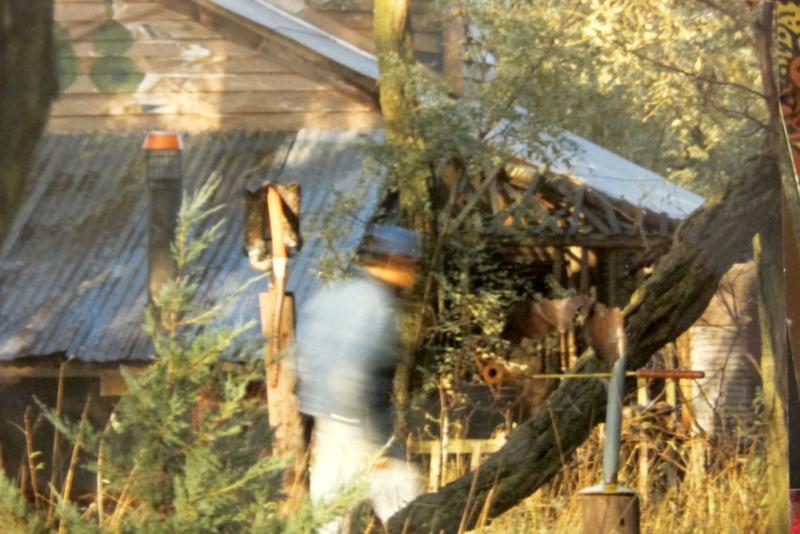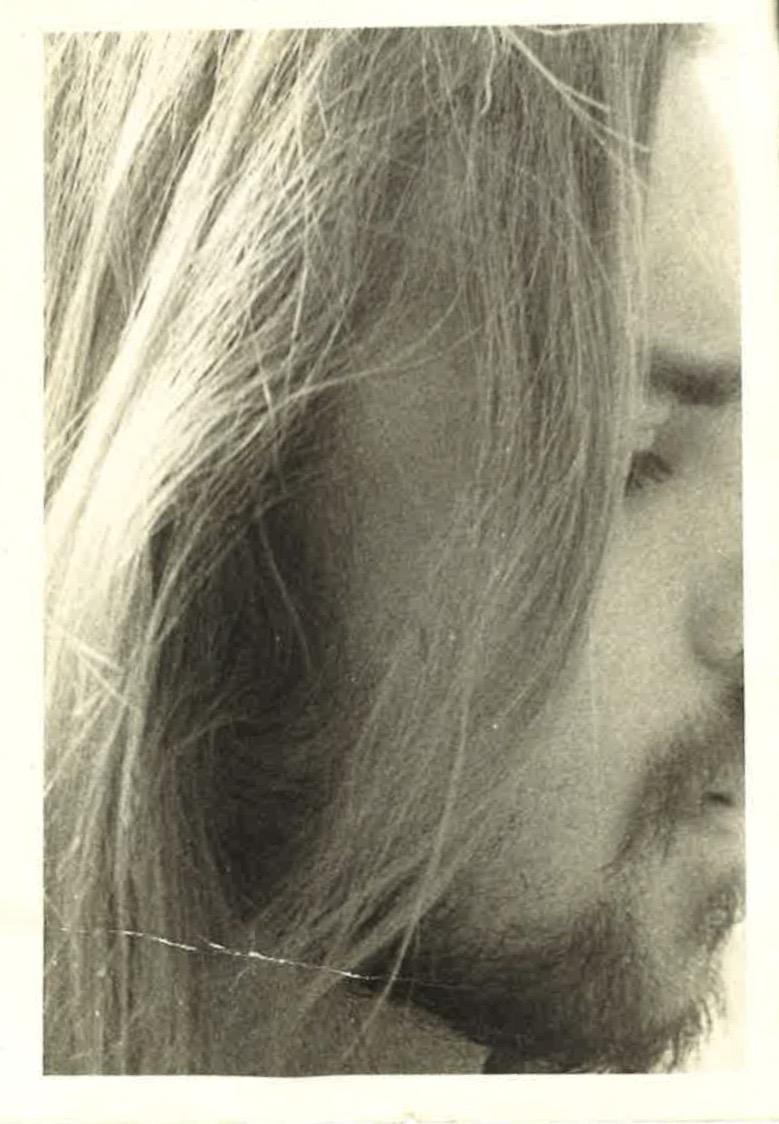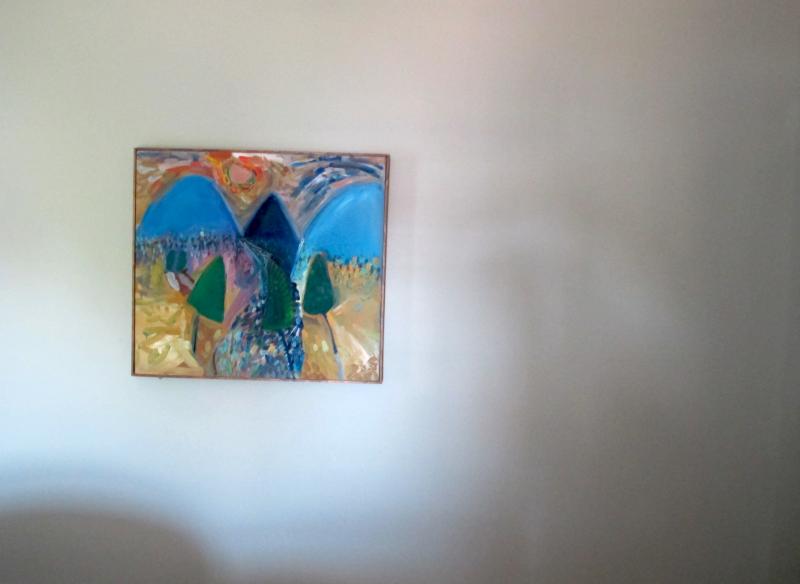Laura A. L. Wellen

James Dean Pruner, near his home, ca. 1984. Photograph by Jean Stramel.
For the past two years, I’ve been researching a community of artists that swirled around Kansas painter, printmaker, and zinester James Dean Pruner (1951–1987/88). After earning his MA in painting in 1976, Pruner moved out to rural Stafford County and lived on a piece of land so remote he drew careful maps for his friends to find him. One map says, "Undesirable types welcome if you have a good sense of humor or you're a poet." His friends were artists, musicians, and activists, anti-Vietnam War, anti-big agriculture hippies and bohemians, and every year they celebrated April Fool's Day together on his property. I drive across Kansas, collecting letters and ephemera, talking to people who were part of that community, asking them to remember.
I have been traveling to Kansas since we moved away from there, when I was six. But my recent trips have been to follow Jim, who was my mother's cousin, and to try and understand what it was like to be an artist there in the 70s and 80s. I rent a car and drive for days, stopping in Kansas City, Lawrence, Wilson, Stafford, Hays, Ellinwood, Hutchinson, and Great Bend. Jim died around the same time I left Kansas. As I write this, I am the same age he was when he died.
When I mention this project to colleagues, they often think Jim and his friends must have been outsider artists. No, wait, I always say. Jim wasn’t. He was just a long way from New York (1400 miles) and Los Angeles (1300 miles) and Chicago (770) and Houston (690). Being distant is, I guess, a different kind of relationship to the outside.
There is no good word for artists like Pruner, artists who live(d) in remote places, who never moved in gallery or museum circuits, but who studied art and placed themselves within specific visual traditions—abstraction, for example, or conceptual art, or regionalism. They simply disappear from the canons or counter-canons. And although he was geographically outside, outsider isn’t the right word either.
When I meet John Eberly for the first time, at his office in the Reno County Department of Aging, he is reluctant to talk to me. I persist. He relents. John attended art school with Jim. He is sensitive to Kansas and the many kinds of knowledge embedded in its geography. We discover we are friends. We make a written conversation about some of these things. This is one way that I will write a history of Jim's community.
John describes his working life like this:
"janitor, commercial artist, bookstore manager, librarian, college professor, film coordinator, window washer, obit clerk, non-profit director, farm hand, substitute preacher, development director, magazine editor, surveyor, amusement park flunky, homeless shelter assistant director, RSVP volunteer coordinator, public speaker, actor, carpenter, paperboy, sound man, stage hand, light man, one-man-band, kissing bandit, Sunday school teacher, disability case manager, bartender, social and human services assistant, meditation teacher, …writer, artist, musician, unrepentant bohemian."
But what does a bohemian in Kansas look like? I ask him.
John writes back, "I like to think it means a conscious refusal of entering the 'stream'–going against that stream, actually–of the status quo, not desiring the usual things that go along with material success, valuing the appreciation and creation of art and literature and music over the compulsion to make a lot of money, or to seek mainstream fame. In Kansas it means to work as a farm hand rather than becoming a farmer, for example, because you enjoy driving a tractor around a field all day without the need to spend sleepless nights worrying about whether or not it will rain, or if the price of wheat has gone up or down… When the underground cultural shift occurred in the mid to late 1970’s from 'hippie' to 'punk' the boho lifestyle didn’t really change much except for the haircuts. For men, the versatility of a spikey punk hairdo lent itself well to becoming a combed short well-groomed look for that all-important job interview than did, say, a ponytail. When I personally made that transition, after being a hippie for almost ten years, it was like assuming an alternate identity, being able to live amongst the regular folks, to keep your underground beliefs and identity, and disappear into the 'straight' crowd. ...what I’m saying is: beyond this long list of social and economic masks I’ve worn, underneath it all I am still basically a dropout, an outcast, a multitude of asocial personalities, and I revel in them all without explanation, regret, or need to apologize, rather, this is who I am and most will never really know me, and that’s a very good thing indeed."
In the 1970s and 1980s, there was a burgeoning underground cultural scene in the Midwest. William Burroughs had something to do with this, and the university culture in towns like Lawrence and Hays, but I think it ran much deeper. There was something that drew the Beats to Kansas: call it magic, call it "a palpable presence," call it a tension with the landscape.
"People like to point to Allen Ginsberg’s poem 'Wichita Vortex Sutra,'" John writes, "and of course he came here and wrote that a long time before Burroughs's move to Kansas... My friend Paul Hawkins and I used to go all over the state investigating petroglyph sites and other ancient Native American vision questing sites like Penokee Man out in Graham County, and the Serpent Intaglio. At one such petroglyph site near Lyons, KS, close to the Serpent Intaglio, where the dark brown limestone has been violently compressed by nature, there is a palpable presence, a felt 'deep earth' presence. A local once told me that near this site people often have fatal car accidents. His explanation was that it lies on a grid of 'power lines' (like Ley lines) that pulsate through the earth. Paul and I would often drum and meditate, sing and chant at these sites, have visions, interesting experiences, and come away with similar and also wildly different stories of what had happened to us. There’s a soul to this place, like a heart beating, throughout the Midwest..."
I remind John of how we met, how he wasn't interested in meeting me or talking about Jim. "I remember you telling me that you had no interest in making that period something heroic or overblown," I say.
"Yes, you’re right I was hesitant to talk with you about Jim and those days because the way I (still) look at it, it was simply what we were doing at the time, we had no sense of being involved in any kind of dynamic art movement or that any of us were particularly 'special' in any way, we were just young, creative people caught up in the youth movement flavor of the moment, 'doing our thing.' I think it’s impossible to understand the significance of the moment. It’s all in hindsight. Art for me is a process. Once the process is complete, you have an artifact... This is not to say Jim’s work is not still relevant or interesting and important today. I believe it is. I am just saying that as an artist, he was caught in the whirlwind of circumstances and events going on around him in his life as all of us are in our own.”
John and Jim both worked as janitors on campus at Emporia State University. Both were painters, and studied with painting instructors Rex Hall and Richard Slimon. John describes Hall as an "abstract regionalist," and Slimon as an immediate heir to German Expressionism (he studied with Max Beckmann at Washington University in St. Louis). "What I recall about what Jim was painting at the time were fast studies on gesso’d paper influenced by Picasso’s Les Demoiselles d'Avignon and that period, but in a broader, looser painting style with jarring color combinations that resembled de Kooning...
Cincinnati city bus on private land; studio of James Dean Pruner. Photograph by Laura A. L. Wellen, 2014.
"Jim gave a large painting of a female nude to my roommate that hung on the wall in our apartment’s living room. We had a lot of mutual friends, most of them artists as well, painters, and some ceramics students. Hippies. Bohemians. We had a nude beach just south of town at a former sand pit for Christ’s sake! We all lived within the starving artist archetype, in roach-infested horrible student falling-down housing, in buses and cars and yards and wherever we could land. We wore tie-dye, torn up jeans, and bandannas, took mind-altering drugs and drank copious amounts of alcohol. We partied hard. We slept with each other… After college when we parted ways and others stayed together or moved away together some of us stayed in touch, often through our connection with art. That was how Jim and I continued to know each other. In Emporia, through Chester Press, Jim and our friend Ellen Ferguson published little black-and-white booklets of drawings... Jim’s comics (I use the term broadly, he may have thought of it differently), the publications One (1) Day Close to Hell and The Rain’s Falling On Hard Nose Harry form, in my opinion, a bridge between his painting style and the character and narrative-driven large paintings he was also making at the time."
John continues to paint, and is going back to cartooning. He recently completed his first solo mini-comic in 30 years, called Blowfish. He tells me about his years making comics, sending them out to a pre-Internet network, charting lists of P.O. boxes around the country. He shares the handful of publications he still keeps around. At one point, he threw away boxes of printed matter. He tells me about watching the garbage trucks carry it all away. We talk a lot about loss and what we think it is.

Photograph of John Eberly, October 1976. Photographer unknown. Collection of John Eberly.
John recently returned to alchemy, and I tell him how I imagine alchemy is somehow rooted in a very intimate experience in the landscape, a way of finding magic there, alone.
"When we moved to the Hutchinson area in the early 1990’s so I could teach Art History at the community college, we lived out in the boonies in an old trailer house next to a creek and a wide expanse of wilderness," John writes. "Every day I would go on woods walks, sometimes falling asleep in a hollow cottonwood tree trunk by the babbling water’s edge. While still in Wichita I met a witch (ha!) who initiated me into naturopathy and homeopathy, the art of using plants and their essences to heal. When we moved to the country, my mother-in-law knew all of the wild plants in the area and taught me a lot about them. Pretty soon I noticed the plants were 'communicating' with me, sometimes guiding me to certain places, for example, where a patch of Melissa (Lemon Balm) grew wild... I started making my own crude tinctures, combining plants with wine or grain alcohol to leach the essence from the plant."
I imagine Pruner as something of an alchemist, trying to make a sustainable living as an artist so very far from any town or city, museum or gallery. The Kansas landscapes are complicated, diverse, change rapidly. They are violent, and flat, and windy, and they can be brutally lonely. I imagine him working there. I listen to recordings of him playing music there. I look at seemingly endless paintings of the Flint Hill landscape, of mystical figures in a flat, endless horizon.
"I know what you mean about Kansas being a haunted landscape. It’s full of ghosts," John says.
He tells me, in beautiful, winding descriptions about Seneca, where he grew up. The county seat of Nemaha County Kansas, Seneca "is in a green bowl of a valley where rain and snow collect and drift but cannot escape," he writes. "My adopted Dad and I used to fish and explore the lake, ending our hot summer afternoons at Big Jay’s, an old 1940’s roadhouse. Dad would drink a red beer and maybe eat a pickled egg out of a big murky jar on the bar, and I would have a grape pop with peanuts drink-a-bite style. In between the lake and town, off the highway heading west, was a dusty road I used to take solitary walks on. An old abandoned farmhouse set back off the road at one point, and I would explore it, imagining a family trying to make a stand out here farming the dust, then finally giving up and leaving. I always wondered who they were. I found an old hat, a raccoon in a closet, stairs without railing going up to bedrooms with rose-colored wallpaper hanging down in shreds, a disintegrating piece of an old newspaper floating weightless in the wind blowing through a broken window, and quiet spiders..."
There's an intuitive long history, I think, a huge amount of time both geological and human that makes the plains feel haunted. It's not unique to the region; I feel it on drives through the South, too, and I'm sure it exists in many places. Connecting magic and affect to landscape seems to be a constant human impulse, we agree, as we talk about regional archeology, mound-building, petroglyphs, and feelings we have in sacred spaces.
"Yes, I think most Americans unconsciously dismiss regional history as unimportant–to our own peril!" John writes. "As transplanted people from all over the world, we tend to not think–if we think about it at all–farther back than 1776 or so when the country was founded… But the spirit and soul of the original cultures haunt the landscape, invested with the blood of countless generations…"
***
There is a point in most of the interviews I do about Pruner, where the person I am interviewing pauses, then says, “You know, I still have this dream about Jim.” Each dream is different, and each tells me something about the dreamer. Most deal with Jim’s disappearance in December of 1987. His disappearance means that there are old arguments unresolved, and relationships broken off abruptly. I think about dreams and other kinds of memory as content for writing a history, and what they might offer in a place where an art history has not yet been written.

James Dean Pruner, Untitled painting from Moonlit Night Over Cleveland, Ohio series, n.d., private collection. Photograph by Laura A. L. Wellen, 2014.
For many people, what endures about Jim’s work is tied to a personal experience with the artist, a specific memory. But for me, the personal experience is with a landscape painting. Moonlit Night Over Cleveland Ohio, an undated oil painting, hung in my childhood bedroom. The painting was one of a series, with slight variations in size and color. Mine, with its rich hues of blue and green, thickly impastoed trees, and reflected cones of light, fascinated me as a young person. It drew me in, and it felt real. It was my first experience of a painted abstraction.
In each version of the Cleveland landscape, three arches in the background (what I always imagined to be views under an overpass) change and shift, sometimes becoming more clearly a range of hills or mountains. I think this is an interesting ambiguity in the painting: that the landscape can morph from a cityscape to a mountainscape illuminates a way of moving through the world, being open to the weird potentials of landscapes, their inexplicability.
In April of last year, as I drove through Kansas, I stopped often to take in the landscape. Spring there is a study in changes, with immense skies that shift in gradations of color from one moment to another. The dirt roads surrounded by fields of young wheat pair the warm brown and rich green in a startling way. As night comes, late, the moon hangs over the fields, and the wind is a relentless and badgering presence, a constant sound. I remember Jim from when I was a small child. In my memory, he was always quietly on the periphery of family gatherings. Driving alone through this landscape, which is both familiar and surprising to me, Jim remains a kind of abstraction, pieced together through letters and images, stories and vague memories. But mostly, through this feeling I get when I stand outside, I feel connected to something he also connected to, something that haunts and intrigues John Eberly and other artists I interview in Kansas. We are so incredibly small and fragile in these rolling, grassy hills. If the wind blows just a bit harder, we might splinter apart and scatter, becoming what perhaps we always already were: a certain kind of abstraction, a composite whole made from lifetimes of chance encounters. John and I write back and forth about many things, sharing book recommendations, music, memories, texts we're working on. Maybe it makes me a bad art historian to befriend a research subject, to be related to another. I write to him, "One of those lucky coincidences that the universe sometimes lets us have––the fact that our paths crossed," and he writes back, "I agree completely, Laura."
Laura A. L. Wellen, PhD, is a writer and independent curator based in Guatemala City and Houston. In 2016, she co-founded the apartment gallery and artist residency Yvonne in Guatemala; she is also the co-founder of the Houston-based project Francine. She is currently a writing fellow at the Core Critical Studies Program of The Museum of Fine Arts, Houston. Her texts have been published in Artforum, Artishock, Art Lies, Art Review, Arts + Culture Texas, ...mightbegood, and in numerous international artist books and exhibition catalogs.
